Wireless Network Communication Assignment Solution - MITS5003, 2019S2
VerifiedAdded on 2022/12/18
|10
|1465
|58
Homework Assignment
AI Summary
This document provides a comprehensive solution to a Wireless Network Communication assignment (MITS5003). The assignment covers several key topics including the IP and network access layers, communication scenarios between prime ministers utilizing translators and telephones, analysis of waveforms including amplitude, time period, frequency, and phase. It also includes calculations related to signal representations, free space loss, fundamental frequency, bandwidth, channel capacity based on Nyquist's theorem, a comparison of packet switching and circuit switching, and calculations for antenna heights. References are provided at the end of the document.

MITS5003 0
Wireless Network & Communication
Wireless Network & Communication
Paraphrase This Document
Need a fresh take? Get an instant paraphrase of this document with our AI Paraphraser
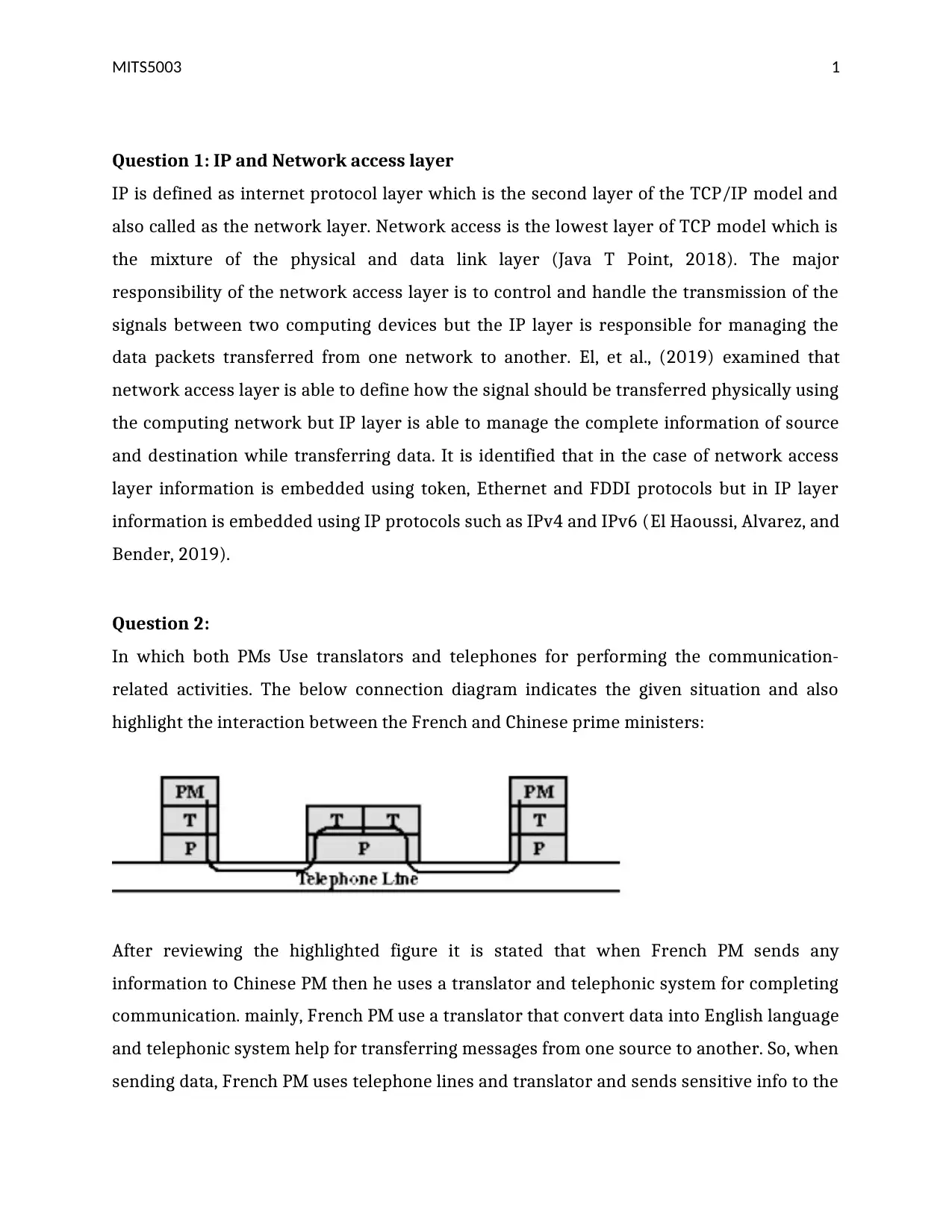
MITS5003 1
Question 1: IP and Network access layer
IP is defined as internet protocol layer which is the second layer of the TCP/IP model and
also called as the network layer. Network access is the lowest layer of TCP model which is
the mixture of the physical and data link layer (Java T Point, 2018). The major
responsibility of the network access layer is to control and handle the transmission of the
signals between two computing devices but the IP layer is responsible for managing the
data packets transferred from one network to another. El, et al., (2019) examined that
network access layer is able to define how the signal should be transferred physically using
the computing network but IP layer is able to manage the complete information of source
and destination while transferring data. It is identified that in the case of network access
layer information is embedded using token, Ethernet and FDDI protocols but in IP layer
information is embedded using IP protocols such as IPv4 and IPv6 (El Haoussi, Alvarez, and
Bender, 2019).
Question 2:
In which both PMs Use translators and telephones for performing the communication-
related activities. The below connection diagram indicates the given situation and also
highlight the interaction between the French and Chinese prime ministers:
After reviewing the highlighted figure it is stated that when French PM sends any
information to Chinese PM then he uses a translator and telephonic system for completing
communication. mainly, French PM use a translator that convert data into English language
and telephonic system help for transferring messages from one source to another. So, when
sending data, French PM uses telephone lines and translator and sends sensitive info to the
Question 1: IP and Network access layer
IP is defined as internet protocol layer which is the second layer of the TCP/IP model and
also called as the network layer. Network access is the lowest layer of TCP model which is
the mixture of the physical and data link layer (Java T Point, 2018). The major
responsibility of the network access layer is to control and handle the transmission of the
signals between two computing devices but the IP layer is responsible for managing the
data packets transferred from one network to another. El, et al., (2019) examined that
network access layer is able to define how the signal should be transferred physically using
the computing network but IP layer is able to manage the complete information of source
and destination while transferring data. It is identified that in the case of network access
layer information is embedded using token, Ethernet and FDDI protocols but in IP layer
information is embedded using IP protocols such as IPv4 and IPv6 (El Haoussi, Alvarez, and
Bender, 2019).
Question 2:
In which both PMs Use translators and telephones for performing the communication-
related activities. The below connection diagram indicates the given situation and also
highlight the interaction between the French and Chinese prime ministers:
After reviewing the highlighted figure it is stated that when French PM sends any
information to Chinese PM then he uses a translator and telephonic system for completing
communication. mainly, French PM use a translator that convert data into English language
and telephonic system help for transferring messages from one source to another. So, when
sending data, French PM uses telephone lines and translator and sends sensitive info to the

MITS5003 2
Chinese PM which contains a translator and telephone system for converting signals into
the English linguistic. Therefore, for performing data transmission activities between both
PMs Translator and telephone play a crucial character which reduces problems and issues
from the system.
Question 3
For first wave:
Amplitude= 15
Time period= 3 seconds
Frequency= 0.33 Hz
Phase= 0 degree
Chinese PM which contains a translator and telephone system for converting signals into
the English linguistic. Therefore, for performing data transmission activities between both
PMs Translator and telephone play a crucial character which reduces problems and issues
from the system.
Question 3
For first wave:
Amplitude= 15
Time period= 3 seconds
Frequency= 0.33 Hz
Phase= 0 degree
⊘ This is a preview!⊘
Do you want full access?
Subscribe today to unlock all pages.

Trusted by 1+ million students worldwide
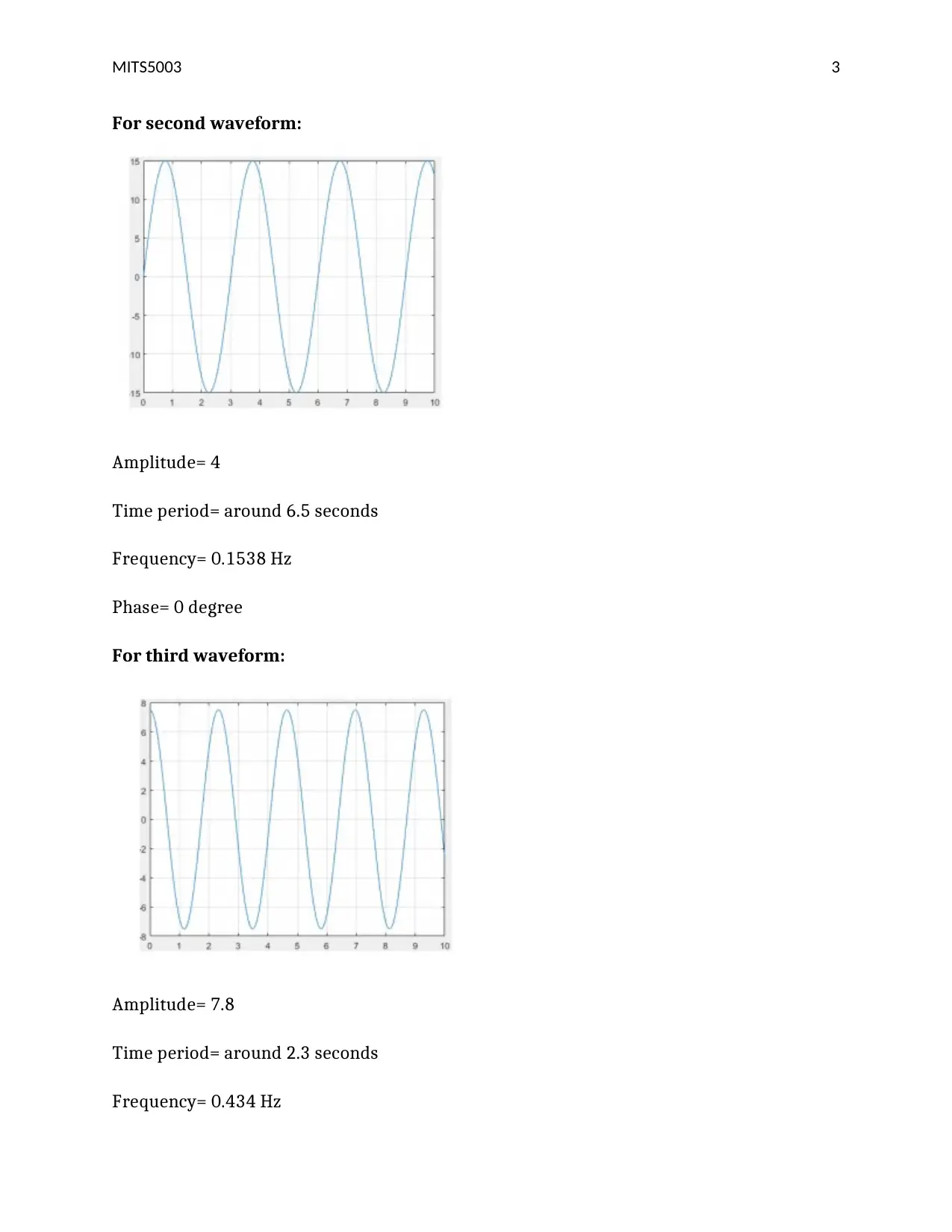
MITS5003 3
For second waveform:
Amplitude= 4
Time period= around 6.5 seconds
Frequency= 0.1538 Hz
Phase= 0 degree
For third waveform:
Amplitude= 7.8
Time period= around 2.3 seconds
Frequency= 0.434 Hz
For second waveform:
Amplitude= 4
Time period= around 6.5 seconds
Frequency= 0.1538 Hz
Phase= 0 degree
For third waveform:
Amplitude= 7.8
Time period= around 2.3 seconds
Frequency= 0.434 Hz
Paraphrase This Document
Need a fresh take? Get an instant paraphrase of this document with our AI Paraphraser
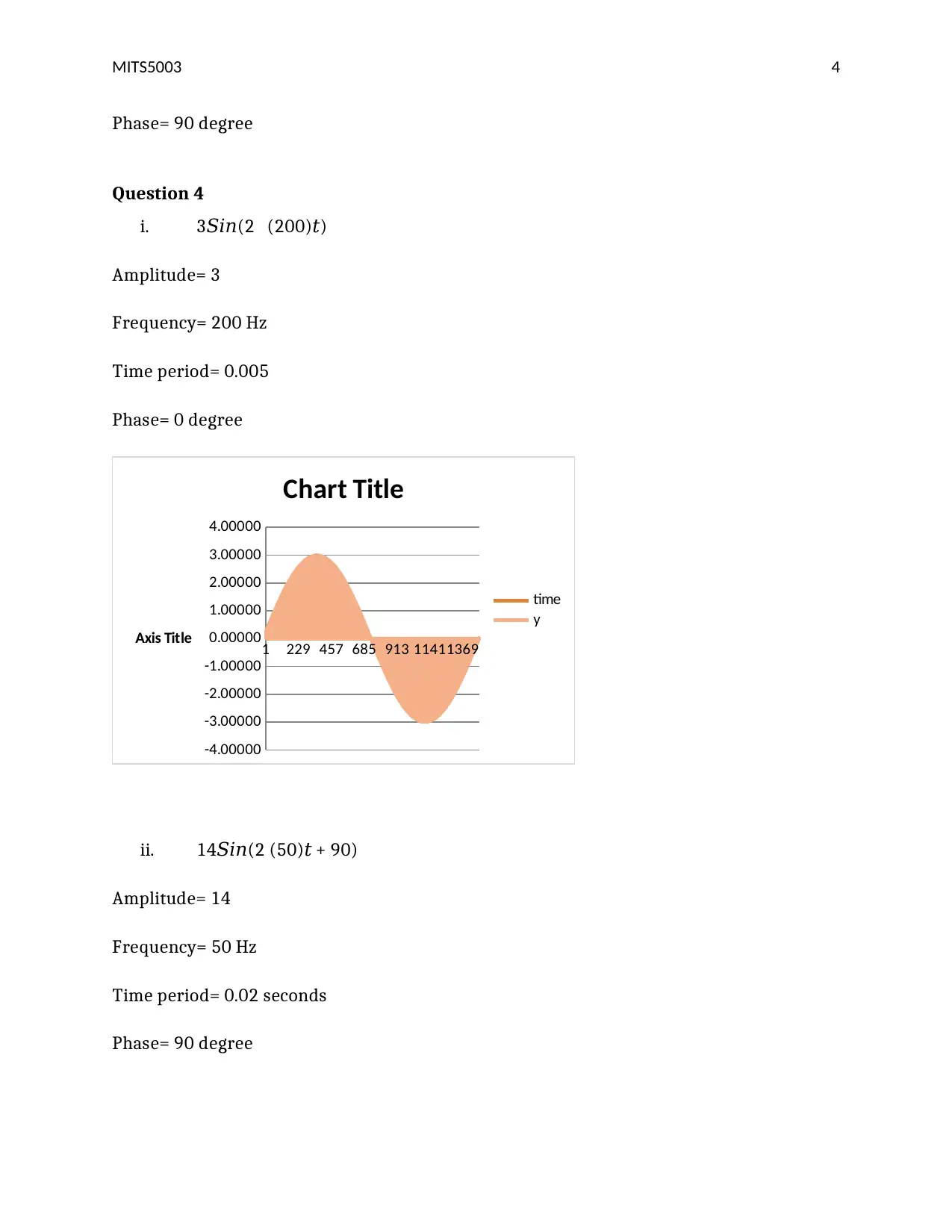
MITS5003 4
Phase= 90 degree
Question 4
i. 3𝑆𝑖𝑛(2𝜋 (200)𝑡)
Amplitude= 3
Frequency= 200 Hz
Time period= 0.005
Phase= 0 degree
1 229 457 685 913 11411369
-4.00000
-3.00000
-2.00000
-1.00000
0.00000
1.00000
2.00000
3.00000
4.00000
Chart Title
time
y
Axis Title
ii. 14𝑆𝑖𝑛(2𝜋(50)𝑡 + 90)
Amplitude= 14
Frequency= 50 Hz
Time period= 0.02 seconds
Phase= 90 degree
Phase= 90 degree
Question 4
i. 3𝑆𝑖𝑛(2𝜋 (200)𝑡)
Amplitude= 3
Frequency= 200 Hz
Time period= 0.005
Phase= 0 degree
1 229 457 685 913 11411369
-4.00000
-3.00000
-2.00000
-1.00000
0.00000
1.00000
2.00000
3.00000
4.00000
Chart Title
time
y
Axis Title
ii. 14𝑆𝑖𝑛(2𝜋(50)𝑡 + 90)
Amplitude= 14
Frequency= 50 Hz
Time period= 0.02 seconds
Phase= 90 degree
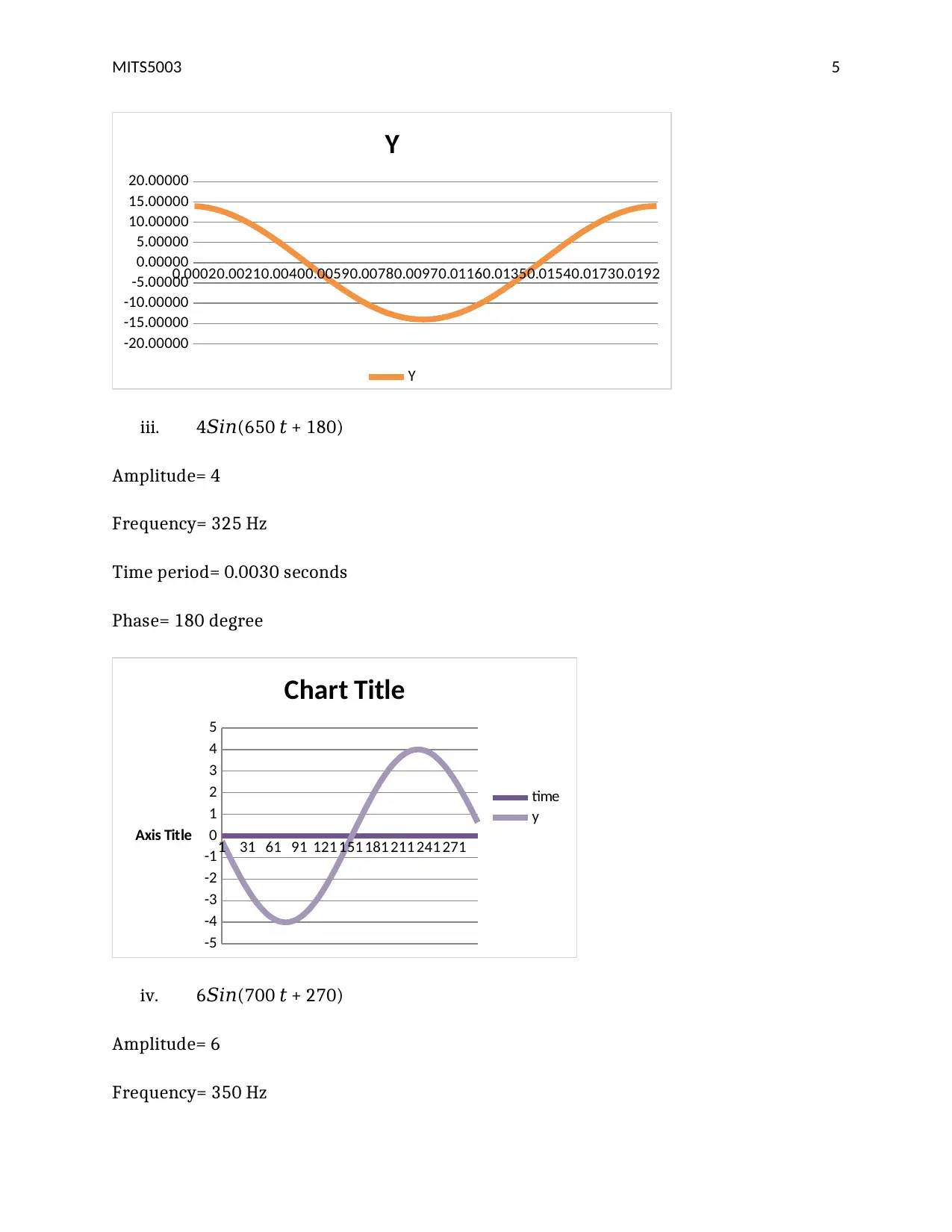
MITS5003 5
0.00020.00210.00400.00590.00780.00970.01160.01350.01540.01730.0192
-20.00000
-15.00000
-10.00000
-5.00000
0.00000
5.00000
10.00000
15.00000
20.00000
Y
Y
iii. 4𝑆𝑖𝑛(650𝜋𝑡 + 180)
Amplitude= 4
Frequency= 325 Hz
Time period= 0.0030 seconds
Phase= 180 degree
1 31 61 91 121 151 181 211 241 271
-5
-4
-3
-2
-1
0
1
2
3
4
5
Chart Title
time
y
Axis Title
iv. 6𝑆𝑖𝑛(700𝜋𝑡 + 270)
Amplitude= 6
Frequency= 350 Hz
0.00020.00210.00400.00590.00780.00970.01160.01350.01540.01730.0192
-20.00000
-15.00000
-10.00000
-5.00000
0.00000
5.00000
10.00000
15.00000
20.00000
Y
Y
iii. 4𝑆𝑖𝑛(650𝜋𝑡 + 180)
Amplitude= 4
Frequency= 325 Hz
Time period= 0.0030 seconds
Phase= 180 degree
1 31 61 91 121 151 181 211 241 271
-5
-4
-3
-2
-1
0
1
2
3
4
5
Chart Title
time
y
Axis Title
iv. 6𝑆𝑖𝑛(700𝜋𝑡 + 270)
Amplitude= 6
Frequency= 350 Hz
⊘ This is a preview!⊘
Do you want full access?
Subscribe today to unlock all pages.

Trusted by 1+ million students worldwide
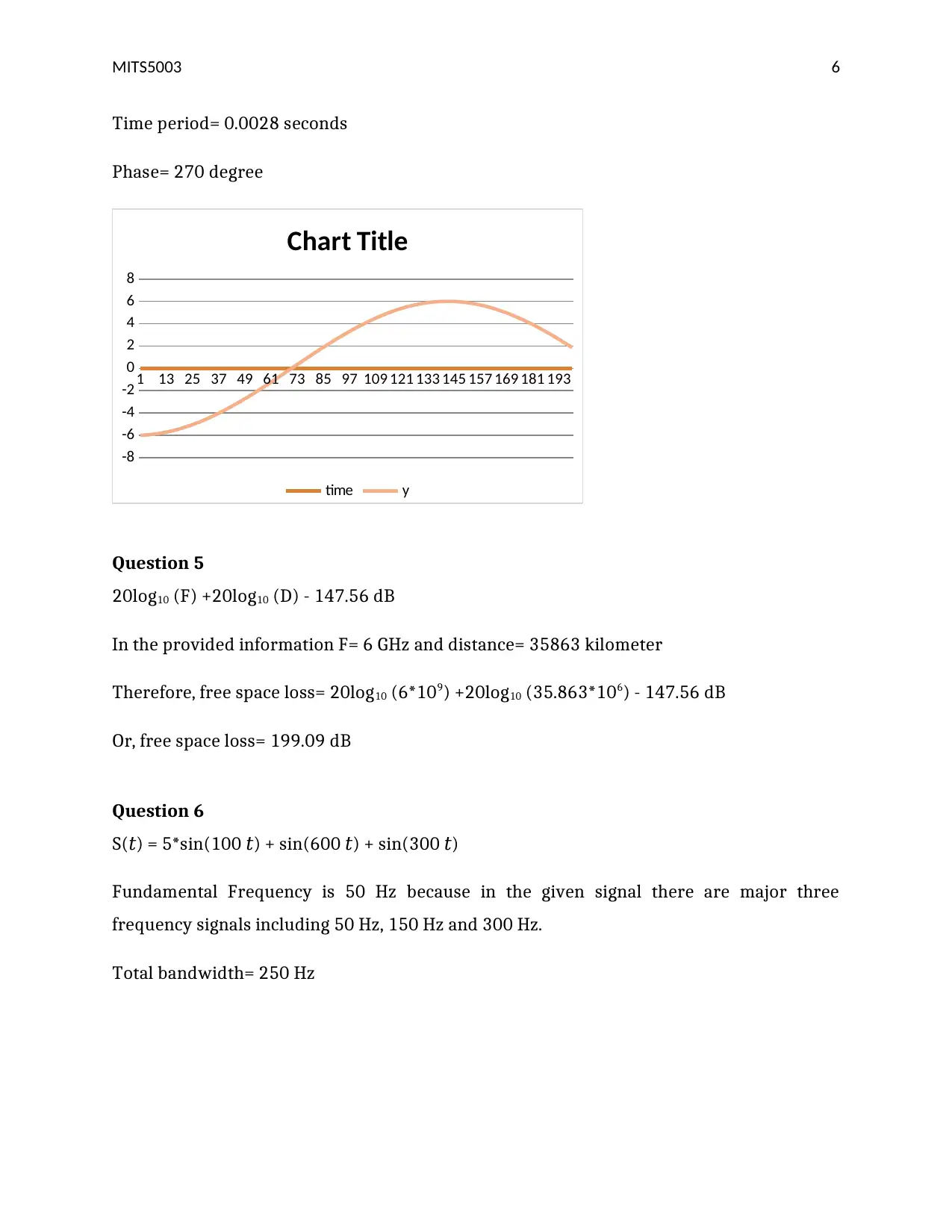
MITS5003 6
Time period= 0.0028 seconds
Phase= 270 degree
1 13 25 37 49 61 73 85 97 109 121 133 145 157 169 181 193
-8
-6
-4
-2
0
2
4
6
8
Chart Title
time y
Question 5
20log10 (F) +20log10 (D) - 147.56 dB
In the provided information F= 6 GHz and distance= 35863 kilometer
Therefore, free space loss= 20log10 (6*109) +20log10 (35.863*106) - 147.56 dB
Or, free space loss= 199.09 dB
Question 6
S(𝑡) = 5*sin(100𝜋𝑡) + sin(600𝜋𝑡) + sin(300𝜋 )𝑡
Fundamental Frequency is 50 Hz because in the given signal there are major three
frequency signals including 50 Hz, 150 Hz and 300 Hz.
Total bandwidth= 250 Hz
Time period= 0.0028 seconds
Phase= 270 degree
1 13 25 37 49 61 73 85 97 109 121 133 145 157 169 181 193
-8
-6
-4
-2
0
2
4
6
8
Chart Title
time y
Question 5
20log10 (F) +20log10 (D) - 147.56 dB
In the provided information F= 6 GHz and distance= 35863 kilometer
Therefore, free space loss= 20log10 (6*109) +20log10 (35.863*106) - 147.56 dB
Or, free space loss= 199.09 dB
Question 6
S(𝑡) = 5*sin(100𝜋𝑡) + sin(600𝜋𝑡) + sin(300𝜋 )𝑡
Fundamental Frequency is 50 Hz because in the given signal there are major three
frequency signals including 50 Hz, 150 Hz and 300 Hz.
Total bandwidth= 250 Hz
Paraphrase This Document
Need a fresh take? Get an instant paraphrase of this document with our AI Paraphraser
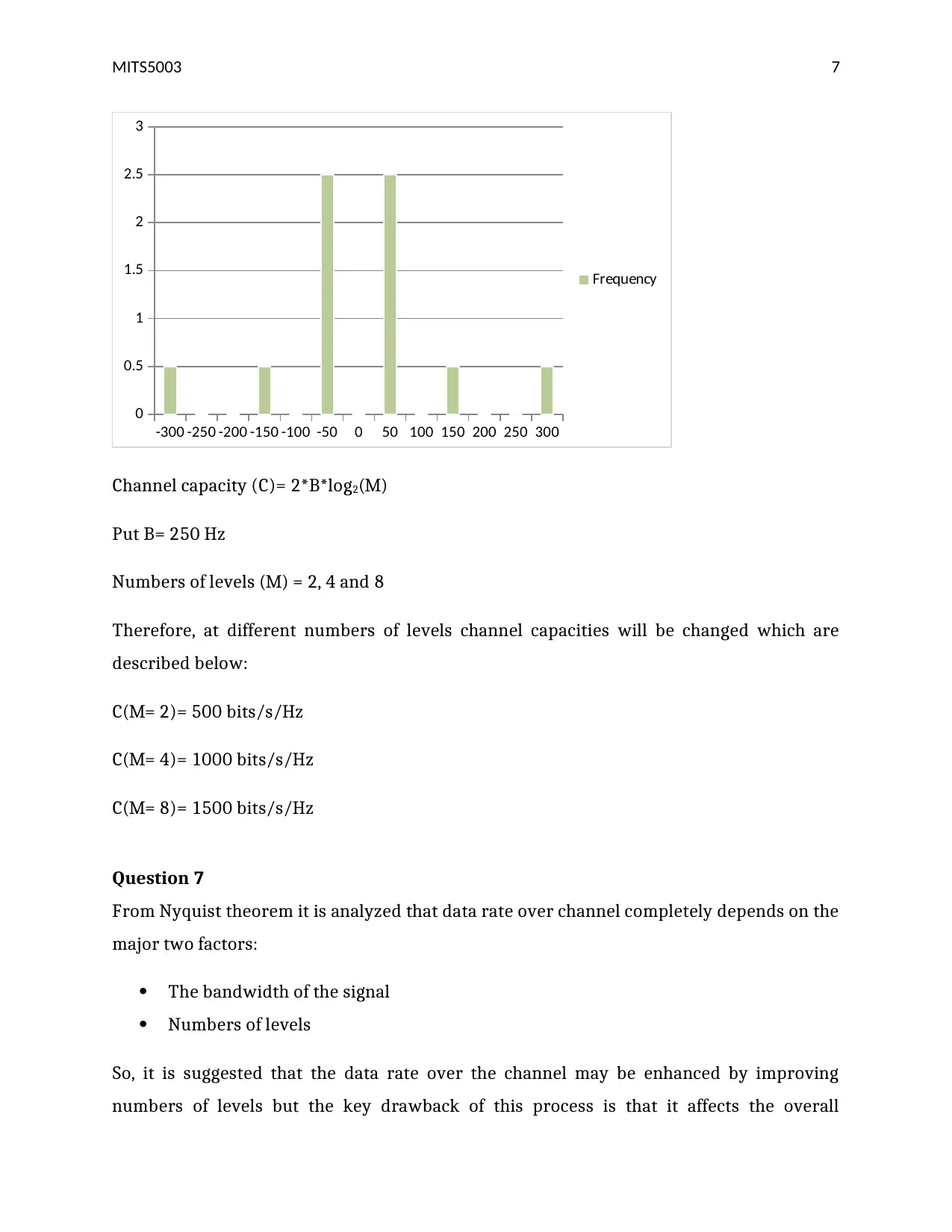
MITS5003 7
-300 -250 -200 -150 -100 -50 0 50 100 150 200 250 300
0
0.5
1
1.5
2
2.5
3
Frequency
Channel capacity (C)= 2*B*log2(M)
Put B= 250 Hz
Numbers of levels (M) = 2, 4 and 8
Therefore, at different numbers of levels channel capacities will be changed which are
described below:
C(M= 2)= 500 bits/s/Hz
C(M= 4)= 1000 bits/s/Hz
C(M= 8)= 1500 bits/s/Hz
Question 7
From Nyquist theorem it is analyzed that data rate over channel completely depends on the
major two factors:
The bandwidth of the signal
Numbers of levels
So, it is suggested that the data rate over the channel may be enhanced by improving
numbers of levels but the key drawback of this process is that it affects the overall
-300 -250 -200 -150 -100 -50 0 50 100 150 200 250 300
0
0.5
1
1.5
2
2.5
3
Frequency
Channel capacity (C)= 2*B*log2(M)
Put B= 250 Hz
Numbers of levels (M) = 2, 4 and 8
Therefore, at different numbers of levels channel capacities will be changed which are
described below:
C(M= 2)= 500 bits/s/Hz
C(M= 4)= 1000 bits/s/Hz
C(M= 8)= 1500 bits/s/Hz
Question 7
From Nyquist theorem it is analyzed that data rate over channel completely depends on the
major two factors:
The bandwidth of the signal
Numbers of levels
So, it is suggested that the data rate over the channel may be enhanced by improving
numbers of levels but the key drawback of this process is that it affects the overall
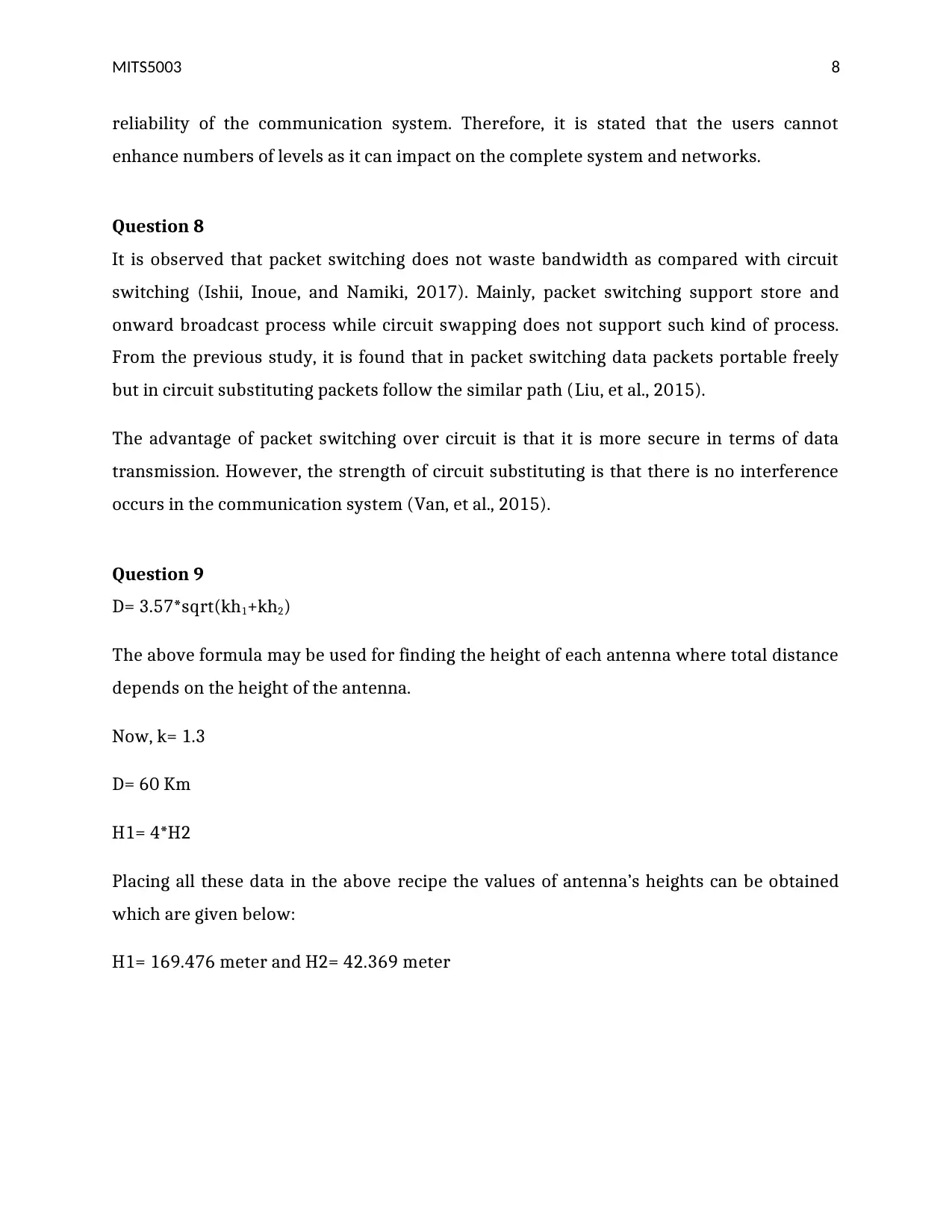
MITS5003 8
reliability of the communication system. Therefore, it is stated that the users cannot
enhance numbers of levels as it can impact on the complete system and networks.
Question 8
It is observed that packet switching does not waste bandwidth as compared with circuit
switching (Ishii, Inoue, and Namiki, 2017). Mainly, packet switching support store and
onward broadcast process while circuit swapping does not support such kind of process.
From the previous study, it is found that in packet switching data packets portable freely
but in circuit substituting packets follow the similar path (Liu, et al., 2015).
The advantage of packet switching over circuit is that it is more secure in terms of data
transmission. However, the strength of circuit substituting is that there is no interference
occurs in the communication system (Van, et al., 2015).
Question 9
D= 3.57*sqrt(kh1+kh2)
The above formula may be used for finding the height of each antenna where total distance
depends on the height of the antenna.
Now, k= 1.3
D= 60 Km
H1= 4*H2
Placing all these data in the above recipe the values of antenna’s heights can be obtained
which are given below:
H1= 169.476 meter and H2= 42.369 meter
reliability of the communication system. Therefore, it is stated that the users cannot
enhance numbers of levels as it can impact on the complete system and networks.
Question 8
It is observed that packet switching does not waste bandwidth as compared with circuit
switching (Ishii, Inoue, and Namiki, 2017). Mainly, packet switching support store and
onward broadcast process while circuit swapping does not support such kind of process.
From the previous study, it is found that in packet switching data packets portable freely
but in circuit substituting packets follow the similar path (Liu, et al., 2015).
The advantage of packet switching over circuit is that it is more secure in terms of data
transmission. However, the strength of circuit substituting is that there is no interference
occurs in the communication system (Van, et al., 2015).
Question 9
D= 3.57*sqrt(kh1+kh2)
The above formula may be used for finding the height of each antenna where total distance
depends on the height of the antenna.
Now, k= 1.3
D= 60 Km
H1= 4*H2
Placing all these data in the above recipe the values of antenna’s heights can be obtained
which are given below:
H1= 169.476 meter and H2= 42.369 meter
⊘ This is a preview!⊘
Do you want full access?
Subscribe today to unlock all pages.

Trusted by 1+ million students worldwide
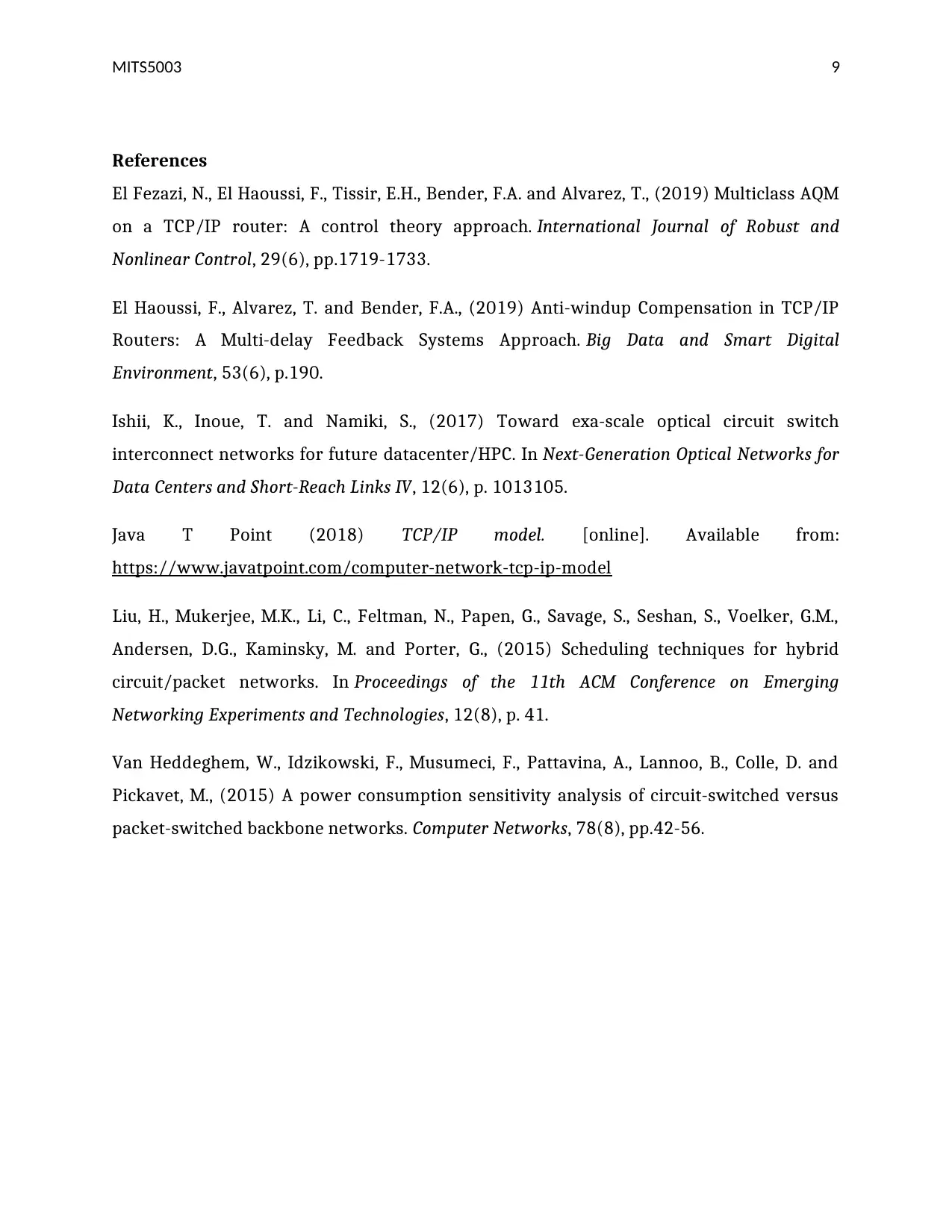
MITS5003 9
References
El Fezazi, N., El Haoussi, F., Tissir, E.H., Bender, F.A. and Alvarez, T., (2019) Multiclass AQM
on a TCP/IP router: A control theory approach. International Journal of Robust and
Nonlinear Control, 29(6), pp.1719-1733.
El Haoussi, F., Alvarez, T. and Bender, F.A., (2019) Anti-windup Compensation in TCP/IP
Routers: A Multi-delay Feedback Systems Approach. Big Data and Smart Digital
Environment, 53(6), p.190.
Ishii, K., Inoue, T. and Namiki, S., (2017) Toward exa-scale optical circuit switch
interconnect networks for future datacenter/HPC. In Next-Generation Optical Networks for
Data Centers and Short-Reach Links IV, 12(6), p. 1013105.
Java T Point (2018) TCP/IP model. [online]. Available from:
https://www.javatpoint.com/computer-network-tcp-ip-model
Liu, H., Mukerjee, M.K., Li, C., Feltman, N., Papen, G., Savage, S., Seshan, S., Voelker, G.M.,
Andersen, D.G., Kaminsky, M. and Porter, G., (2015) Scheduling techniques for hybrid
circuit/packet networks. In Proceedings of the 11th ACM Conference on Emerging
Networking Experiments and Technologies, 12(8), p. 41.
Van Heddeghem, W., Idzikowski, F., Musumeci, F., Pattavina, A., Lannoo, B., Colle, D. and
Pickavet, M., (2015) A power consumption sensitivity analysis of circuit-switched versus
packet-switched backbone networks. Computer Networks, 78(8), pp.42-56.
References
El Fezazi, N., El Haoussi, F., Tissir, E.H., Bender, F.A. and Alvarez, T., (2019) Multiclass AQM
on a TCP/IP router: A control theory approach. International Journal of Robust and
Nonlinear Control, 29(6), pp.1719-1733.
El Haoussi, F., Alvarez, T. and Bender, F.A., (2019) Anti-windup Compensation in TCP/IP
Routers: A Multi-delay Feedback Systems Approach. Big Data and Smart Digital
Environment, 53(6), p.190.
Ishii, K., Inoue, T. and Namiki, S., (2017) Toward exa-scale optical circuit switch
interconnect networks for future datacenter/HPC. In Next-Generation Optical Networks for
Data Centers and Short-Reach Links IV, 12(6), p. 1013105.
Java T Point (2018) TCP/IP model. [online]. Available from:
https://www.javatpoint.com/computer-network-tcp-ip-model
Liu, H., Mukerjee, M.K., Li, C., Feltman, N., Papen, G., Savage, S., Seshan, S., Voelker, G.M.,
Andersen, D.G., Kaminsky, M. and Porter, G., (2015) Scheduling techniques for hybrid
circuit/packet networks. In Proceedings of the 11th ACM Conference on Emerging
Networking Experiments and Technologies, 12(8), p. 41.
Van Heddeghem, W., Idzikowski, F., Musumeci, F., Pattavina, A., Lannoo, B., Colle, D. and
Pickavet, M., (2015) A power consumption sensitivity analysis of circuit-switched versus
packet-switched backbone networks. Computer Networks, 78(8), pp.42-56.
1 out of 10
Related Documents
Your All-in-One AI-Powered Toolkit for Academic Success.
+13062052269
info@desklib.com
Available 24*7 on WhatsApp / Email
![[object Object]](/_next/static/media/star-bottom.7253800d.svg)
Unlock your academic potential
Copyright © 2020–2025 A2Z Services. All Rights Reserved. Developed and managed by ZUCOL.




